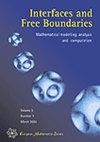活化剂-抑制剂型反应-扩散体系中多尺度模式形成级联
IF 1
4区 数学
Q1 MATHEMATICS
引用次数: 2
摘要
研究了一类激活剂-抑制剂型反应扩散体系的奇异极限,在这些体系中可以形成稳定的、固定的锐界面图案。具体而言,在R中N≥2的适当重新标度的有界域上对FitzHugh-Nagumo模型进行分析。证明了当系统足够接近极限时,从适当的光滑初始数据开始的动力学在分离良好的时间尺度上分解为五个不同的阶段,每个阶段都可以用一个适当的约简问题来近似。该分析允许完全遵循所考虑的系统中形成的时空模式的逐步细化,并为理解由所考虑的一类反应扩散方程建模的大类物理,化学和生物系统中的模式形成场景提供了框架。* CMI法国艾克斯-马赛大学,39 rue frsamdsamric jolio - curie 13453 Marseille cedex 13;法国国家科学研究中心和巴黎- sud Paris-Saclay大学,91405 Orsay cedex, France;美国新泽西理工学院数学科学系,Newark, NJ 07102本文章由计算机程序翻译,如有差异,请以英文原文为准。
A multiple scale pattern formation cascade in reaction-diffusion systems of activator-inhibitor type
A family of singular limits of reaction-diffusion systems of activator-inhibitor type in which stable stationary sharp-interface patterns may form is investigated. For concreteness, the analysis is performed for the FitzHugh-Nagumo model on a suitably rescaled bounded domain in R , with N ≥ 2. It is proved that when the system is sufficiently close to the limit the dynamics starting from the appropriate smooth initial data breaks down into five distinct stages on well-separated time scales, each of which can be approximated by a suitable reduced problem. The analysis allows to follow fully the progressive refinement of spatiotemporal patterns forming in the systems under consideration and provides a framework for understanding the pattern formation scenarios in a large class of physical, chemical, and biological systems modeled by the considered class of reaction-diffusion equations. ∗CMI Université d’Aix-Marseille, 39 rue Frédéric Joliot-Curie 13453 Marseille cedex 13, France †Laboratoire de Mathématiques, CNRS and University Paris-Sud Paris-Saclay, 91405 Orsay Cedex, France ‡Department of Mathematical Sciences, New Jersey Institute of Technology, Newark, NJ 07102, USA
求助全文
通过发布文献求助,成功后即可免费获取论文全文。
去求助
来源期刊
CiteScore
1.70
自引率
0.00%
发文量
17
审稿时长
>12 weeks
期刊介绍:
Interfaces and Free Boundaries is dedicated to the mathematical modelling, analysis and computation of interfaces and free boundary problems in all areas where such phenomena are pertinent. The journal aims to be a forum where mathematical analysis, partial differential equations, modelling, scientific computing and the various applications which involve mathematical modelling meet. Submissions should, ideally, emphasize the combination of theory and application.

 求助内容:
求助内容: 应助结果提醒方式:
应助结果提醒方式:


